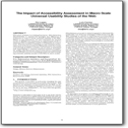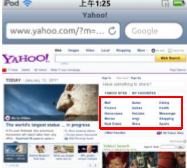论文成果 / Publications
2011
uTable: a seamlessly tiled, very large interactive tabletop system
Abstract
We present uTable, a very large horizontal interactive surface which accommodates up to ten people sitting around and interacting in parallel. We identify the key aspects for building such large interactive tabletops and discuss the pros and cons of potential techniques. After several rounds of trials, we finally chose tiled rear projection for building the very large surface and DI solution for detecting touch inputs. We also present a set of techniques to narrow the interior bezels, uniform the color/brightness of the surface and handle multiple streams of inputs. Finally uTable achieves a good overall performance in terms of display effect and input capability.
Air finger: enabling multi-scale navigation by finger height above the surface
Abstract
We present Air Finger, a novel technique that enables controlling CD ratio by finger height above the touch sur-face for multi-scale navigation tasks. Extending previous research on virtual touch, Air Finger divides the space above surface into two layers and associates the high, medium and low CD ratios to the touch surface, the lower air and the higher air respectively. Users can fluidly switch between the three navigation scales by lifting and pressing the finger. Air Finger enables multi-scale navigation control using one hand.
RegionalSliding: enhancing target selection on touchscreen-based mobile devices
Abstract
Target selection on mobile devices with touchscreens usually gets users into trouble due to the occlusion of the target by the user's finger and ambiguity about which part of the finger generates the result point. In this paper, we propose a novel technique to enhance target selection on touchscreen-based mobile devices, named RegionalSliding, which selectively renders the initially "selected" target as well as its "surrounding" targets in a non-occluded area when users press down on the screen and enables users to complete the selection with sliding gestures according to the visual feedback from the rendered area. A preliminary user study shows that RegionalSliding increases the selection accuracy and brings good user experience.
2010
The satellite cursor: achieving MAGIC pointing without gaze tracking using multiple cursors
Abstract
We present the satellite cursor - a novel technique that uses multiple cursors to improve pointing performance by reducing input movement. The satellite cursor associates every target with a separate cursor in its vicinity for pointing, which realizes the MAGIC (manual and gaze input cascade) pointing method without gaze tracking. We discuss the problem of visual clutter caused by multiple cursors and propose several designs to mitigate it. Two controlled experiments were conducted to evaluate satellite cursor performance in a simple reciprocal pointing task and a complex task with multiple targets of varying layout densities. Results show the satellite cursor can save significant mouse movement and consequently pointing time, especially for sparse target layouts, and that satellite cursor performance can be accurately modeled by Fitts' Law.
Toward Systematical Data Scheduling for Layered Streaming in Peer-to-Peer Networks: Can We Go Farther?
Abstract
Layered streaming in P2P networks has become a hot topic recently. However, the "layered" feature makes the data scheduling quite different from that for nonlayered streaming, and it hasn't been systematically studied yet. In this paper, first, according to the unique characteristics caused by layered coding, we present four objectives that should be addressed by scheduling: throughput, layer delivery ratio, useless packets ratio, and subscription jitter prevention; then a three-stage scheduling approach LayerP2P is designed to request data, where the min-cost flow model, probability decision mechanism, and multiwindow remedy mechanism are used in Free Stage, Decision Stage, and Remedy Stage, respectively, to collaboratively achieve the above objectives. With the basic version of LayerP2P and corresponding experiment results achieved in our previous work, in this paper, more efforts are put on its mechanism details and analysis to its unique features; besides, to further guarantee the performance under sharp bandwidth variation, we propose the enhanced approach by improving the Decision Stage strategy. Extensive experiments by simulation and real network implementation indicate that it outperforms other schemes. LayerP2P has also been deployed in PDEPS Project in China, which is expected to be the first practical layered streaming system for education in P2P networks.
Structured laser pointer: enabling wrist-rolling movements as a new interactive dimension
Abstract
In this paper, we re-visit the issue of multi-point laser pointer interaction from a wrist-rolling perspective. Firstly, we proposed SLP---Structured Laser Pointer, and detects a laser pointer's rotation along its emitting axis. SLP adds the wrist-rolling gestures as a new interactive dimension to the conventional laser pointer interaction approach. We asked a group of users to perform certain tasks using SLP, and derived from test results a set of criteria to distinguish between incidental and intentional SLP rolling, and then the experimental results also approved the high accuracy and acceptable speed as well as throughput of such rolling interaction.
HyMTO: The Hybrid Mesh/Tree Overlay for Large Scale Multimedia Interactive Applications over the Internet
Abstract
In the large scale multimedia interactive applications over the Internet, data can be categorized into the streaming data (e.g. the audio and the video streaming) and the sporadic data (e.g. the annotation in a whiteboard). The mesh-pull overlay fits for the streaming data, for it is resilient in heterogeneous network, while the tree-push overlay is more suitable for the sporadic data, for its easy-to-manage structure can solve the problem of packet loss and disorder. To address the transmission of both types of data, a Hybrid Mesh/Tree Overlay (HyMTO) is proposed in this paper, where the sporadic data and the streaming data are transmitted through different overlays with a novel synchronous scheme. HyMTO can provide the resilient, reliable and ordered transmission for both types of data respectively. Simulations are presented to evaluate the effectiveness and efficiency of HyMTO and a practical e-conference system based on HyMTO is implemented and deployed to demonstrate its practicability and reasonability.
HouseGenie: Universal Monitor and Controller of Networked Devices on Touchscreen Phone in Smart Home
Abstract
Touch screen phone roaming with people features high accessibility and direct-manipulation interaction, regarded as one of the most convenient interfaces for daily life. In this paper, we present HouseGenie to leverage universal monitor and control of networked devices in smart home on touch screen phone. By wirelessly communicating with an OSGi based portal, which maintains all the devices through varied protocols (e.g. industrial standard UPnP or IGRS), HouseGenie facilitates universal home monitor and control: 1) monitoring current status in panoramic view; 2) direct manipulating single/multiple device(s) using pie-menu, list-mode and drag drop gesture; 3) easily controlling devices in several multimodality ways.
SHSim: An OSGI-based smart home simulator
Abstract
With the development of pervasive computing, smart home is increasingly popular. Smart Home usually requires an integration of many heterogeneous devices and service applications in deployment so it is hard and expensive to implement system test. To cope with this problem, this paper describes an OSGI-based smart home simulator named SHSim that is suitable for smart home test. SHSim is built on a dynamic mechanism that allows user to configure the system and test cases easily, and provides device transparent simulation meaning that virtual devices can transplant to real devices with no or little modifications. Practical applications show that SHSim can effectively improve development efficiency and reduce test cost.

